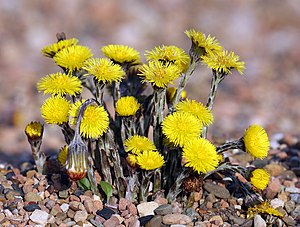Tussilago farfara: Difference between revisions
mNo edit summary |
mNo edit summary |
||
| Line 1: | Line 1: | ||
{{lael | {{lael | ||
|lgtx=[[ἀκρόφυλλον]], [[βηκία]], [[βήκιον]], [[βηχίον]], [[βήχιον]], [[γαβαλήνα]], [[παγγόνατον]], [[πήχιον]], [[πίθιον]], [[χαμαίγειρον]], [[χαμαιλεύκη]] | |lgtx=[[ἀκρόφυλλον]], [[βηκία]], [[βήκιον]], [[βηχίον]], [[βήχιον]], [[γαβαλήνα]], [[παγγόνατον]], [[πήχιον]], [[πίθιον]], [[χαμαίγειρον]], [[χαμαιλεύκη]] | ||
}} | |||
{{wkpen | |||
|wketx=[[File:Coltsfoot.jpg|thumb|Coltsfoot]] Tussilago farfara, commonly known as coltsfoot, is a plant in the tribe Senecioneae in the family Asteraceae, native to Europe and parts of western and central Asia. The name "tussilago" is derived from the Latin tussis, meaning cough, and ago, meaning to cast or to act on. It has had uses in traditional medicine, but the discovery of toxic pyrrolizidine alkaloids in the plant has resulted in liver health concerns. | |||
Tussilago farfara is the only accepted species in the genus Tussilago, although more than two dozen other species have at one time or another been considered part of this group. Most of them are now regarded as members of other genera (Chaptalia, Chevreulia, Farfugium, Homogyne, Leibnitzia, Petasites, Senecio). | |||
}} | }} | ||
Revision as of 17:09, 15 January 2024
Latin > Greek
ἀκρόφυλλον, βηκία, βήκιον, βηχίον, βήχιον, γαβαλήνα, παγγόνατον, πήχιον, πίθιον, χαμαίγειρον, χαμαιλεύκη
Wikipedia EN
Tussilago farfara, commonly known as coltsfoot, is a plant in the tribe Senecioneae in the family Asteraceae, native to Europe and parts of western and central Asia. The name "tussilago" is derived from the Latin tussis, meaning cough, and ago, meaning to cast or to act on. It has had uses in traditional medicine, but the discovery of toxic pyrrolizidine alkaloids in the plant has resulted in liver health concerns.
Tussilago farfara is the only accepted species in the genus Tussilago, although more than two dozen other species have at one time or another been considered part of this group. Most of them are now regarded as members of other genera (Chaptalia, Chevreulia, Farfugium, Homogyne, Leibnitzia, Petasites, Senecio).

